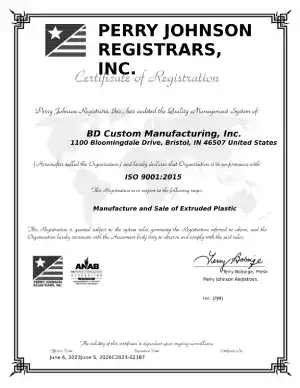PVC vs ABS Plastic Tubing Extrusions
PVC and ABS are two of the most versatile thermoplastic materials on the market and are used extensively throughout numerous facets of the construction industry and beyond. Both plastics are non-toxic and abrasion-resistant, provide improved strength and durability, and offer excellent electrical insulation. Additionally, they are inexpensive and easy to source due to their popularity.
While these materials share some characteristics, they have several distinct properties, making them suitable for different applications.
What is PVC Material?
Polyvinyl chloride (PVC) is a highly versatile, commodity-grade plastic extrusion material. First introduced to the market in the 1920s, this white, initially brittle plastic is one of the most popular thermoplastic polymers in the world. Some advantages and disadvantages of PVC include:
Advantages
- Rigid or flexible. Unplasticized (rigid, RPVC) and plasticized (flexible, FPVC) varieties of PVC are available.
- Excellent chemical resistance. PVC is resistant to common corrosive agents like inorganic acids, alkalis, salts, alcohols, oils, fats, etc.
- Excellent weatherability. PVC contains natural weather-resistant qualities and can be compounded with other additives to further enhance the material’s weatherability against the effects of sunlight, temperature, moisture, etc.
- Excellent electrical insulation. PVC is non-conductive, making it ideal for insulating electrical components.
- Flame retardant. High chlorine content makes PVC challenging to ignite and limits the material’s capacity for heat production. Itsself-extinguishing properties allow the material to stop burning by removing an ignition source.
- Super strong. PVC offers high tensile strength and toughness.
- Lightweight. PVC is lighter than other material alternatives designed for the same applications.
- Durable. PVC is resistant to chemical effects, weathering, corrosion, shock, and abrasion.
- Non-toxic. PVC is non-toxic and adheres to all international health and safety standards.
Disadvantages
- Temperature performance. PVC has a maximum operating temperature of approximately 140 °F before distortion will occur.
- Limited size range. PVC has a small spectrum of component diameters to choose from.
- Lightweight. PVC is easier to work with, but its light weight makes the material prone to cracking.
- Cost. Although PVC is competitive in price and offers many cost-performance advantages, it has a two-step installation process, while the ABS process has only one step. PVC must first be treated with purple primer, which increases overall labor costs. PVC also often requires smoothing to remove burrs, adding even more time to the process. Because of this, PVC can be more expensive than ABS despite its initial price difference.
Applications
Nearly 75% of all PVC use is in applications related to building and construction. Some of its most common uses include:
- Exterior trim
- Channels
- Housings
- Pipes
- Vinyl Sliding
- Wire protection
Though used extensively in construction, PVC is also used in healthcare, household products, packaging, and more.
What is ABS Material?
Acrylonitrile butadiene styrene (ABS) is derived from monomer units of acrylonitrile, butadiene, and styrene. Each provides unique physical and chemical properties to the thermoplastic that make it ideal for numerous industries and applications. Key advantages and disadvantages of ABS include:
Advantages
- Impact resistance. ABS absorbs effects from shock without deformation.
- Structural strength and stiffness. Styrene and butadiene add strength and rigidity that provide structural integrity to the material.
- Chemical resistance. ABS is highly resistant to acids and alkalis.
- Excellent high and low-temperature performance. ABS is resistant to extreme temperatures.
- Great electrical insulation properties. ABS exhibits low electrical and heat conductivity.
- Easy to paint and glue. The glossy finish of ABS is compatible with a range of paints and glues.
- Abrasion resistance. High levels of butadiene create a surface that is nearly insusceptible to wear.
- Excellent mechanical properties. ABS is strong, highly ductile, tough, and impact resistant.
- ABS is more expensive per pound than PVC. However, ABS piping and tubes can be bonded instantly with cement, whereas PVC requires an additional priming step. Although PVC can be less expensive up front, ABS can be the most cost-effective option because it requires less labor.
Disadvantages
- Poor weatherability. UV exposure can cause microcracks in ABS.
- Low solvent resistance. ABS has poor resistance to alcohols, halogenated hydrocarbons, and aromatic hydrocarbons, as well as organic solvents and surfactants like ketone, ester, and ethylene dichloride.
- Hazardous when burned. Temperatures above 750 °F cause ABS to decompose into carcinogenic agents.
- Limited uses. ABS is not an ideal material for applications in the food industry.
Applications
Common applications of ABS include:
- Wire protection
- Electrical pipes
- Automotive trim
- Automotive
- Appliance
- Consumer goods
PVC Plastic Tubing Extrusions with BD Custom Manufacturing
BD Custom Manufacturing has extensive industry knowledge and helps customers craft the perfect tubing and piping solutions for any application. We are the ideal extrusion partner for small to midsize plastics customers across diverse industries, offering:
- Quick turnarounds
- Extensive quality control
- Experienced and capable staff
- Custom tooling design
- Plastic trim molding
- PVC edge trim
- PVC furniture parts
To learn more about our team’s capabilities, please contact us or request a quote today.

